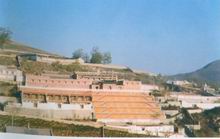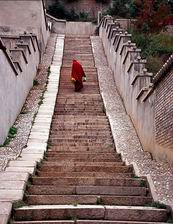| Jixiang Palace

In
1650(Qing Dynasty), Caiwangdanzen, a Mongolian person provided
aid to build Jixiang Palace on, the temporary living place for
Panchen, Dalailama and Chief of Ta’er Monastery. 5th Dalailama
stayed in Jixiang Palace in 1652 when he first came to Ta’er Monastery.
In 1687, 16th Chief of Ta’er Monastery rebuilt it into a magnificent
palace of Tibetan style with four pillars and three courtyards.
In 1777, Qianglong, emperor of Qing Dynasty sent people to build
wall and gateway for the Palace. In 1809, the Palace was destroyed
in fire accidence and in 1813 it was rebuilt and enshrined with
23 statues of Buddha, including 16 Arhats. The new one had constructions,
like gateway, sutra hall and offices. Then it became the living
place for the Chief of Ta’er Monastery and the temporary living
place for Dalialama and Panchen on their way going to meet the
emperor. 5th, 7th, 13th and 14th Dalailama and 6th, 9th and 10th
Panchen all stayed in it when they came to Ta’er Monastery.
Jixiang Palace has been repaired and enlarged many times
and from 1992 to 1996, government allocated a large amount of
money to repair halls of Ta’er Monastery including the Palace.
Therefore, the palace has current size.
Today one can have a survey of Ta’er Monastery in the Palace.
Big Kitchen
Big Kitchen, northwest
of Dajing Hall, was built in 1689(Qing Dynasty) by Ajia Syraosanbu,
the 16th chief. There are five pots in different sizes made from
crude bronze and the big three of them are from 1.65 to2.6 meters
in caliber and 0.9 to 1.3 meters in depth. The oldest one was
cast in 1810(Qing Dynasty), the other two were built in 1821-1850
and 1897. The pots are not in use at usual time until grand Buddhist
assembly for making tea and cooking rice for the Lamas reading
sutras. The pots can cook rice of 525 kilograms, 20 bulls, ferny
fiber of 150 kilograms, ghee of 100 kilograms and 8 sheep all
together one time.
page
up page down
|



